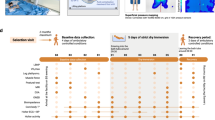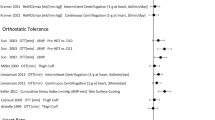Abstract
Background
Space motion sickness (SMS) is the most relevant medical problem during the first days in microgravity. Studies addressing pathophysiology in space face severe technical challenges and microgravity is frequently simulated using the 6° head-down tilt bed rest test (HDT).
Aim
We were aiming to test whether SMS could be simulated by HDT, identify related changes in gastrointestinal physiology and test for beneficial effects of exercise interventions.
Methods
HDT was performed in ten healthy individuals. Each individual was tested in three study campaigns varying by a 30-min daily exercise intervention of either standing, an upright exercise regimen, or no intervention. Gastrointestinal symptoms, stool characteristics, gastric emptying time, and small intestinal transit were assessed using standardized questionnaires, 13C octanoate breath test, and H2 lactulose breath test, respectively, before and at day 2 and 5 of HDT.
Results
Individuals described no or minimal gastrointestinal symptoms during HDT. Gastric emptying remained unchanged relative to baseline data collection (BDC). At day 2 of HDT the H2 peak of the lactulose test appeared earlier (mean ± standard error for BDC-1, HDT2, HDT5: 198 ± 7, 139 ± 18, 183 ± 10 min; p: 0.040), indicating accelerated small intestinal transit. Furthermore, during HDT, stool was softer and stool mass increased (BDC: 47 ± 6, HDT: 91 ± 12, recovery: 53 ± 8 g/day; p: 0.014), indicating accelerated colonic transit. Exercise interventions had no effect.
Conclusion
HDT did not induce symptoms of SMS. During HDT, gastric emptying remained unchanged, but small and large intestinal transit was accelerated.






Similar content being viewed by others
References
Adams GR, Caiozzo VJ, Baldwin KM. Skeletal muscle unweighting: spaceflight and ground-based models. J Appl Physiol. 2003;95:2185–2201.
Afonin BV, Sedova EA, Goncharova NP, Solovieva AA. Investigation of the evacuation function of the gastrointestinal tract during a five day dry immersion. Human Physiol. 2013;39:787–791.
Bluck LJ, Coward WA. Measurement of gastric emptying by the 13C-octanoate breath test—rationalization with scintigraphy. Physiol Meas. 2006;27:279–289.
Caiozzo VJ, Haddad F, Lee S, Baker M, Paloski W, Baldwin KM. Artificial gravity as a countermeasure to microgravity: a pilot study examining the effects on knee extensor and plantar flexor muscle groups. J Appl Physiol. 2009;107:39–46.
Chey WD, Shapiro B, Zawadski A, Goodman K. Gastric emptying characteristics of a novel (13)C-octanoate-labeled muffin meal. J Clin Gastroenterol. 2001;32:394–399.
Davis JR, Vanderploeg JM, Santy PA, Jennings RT, Stewart DF. Space motion sickness during 24 flights of the space shuttle. Aviat Space Environ Med. 1988;59:1185–1189.
Delbende B, Perri F, Couturier O, et al. 13C-octanoic acid breath test for gastric emptying measurement. Eur J Gastroenterol Hepatol. 2000;12:85–91.
Ghoos YF, Maes BD, Geypens BJ, et al. Measurement of gastric emptying rate of solids by means of a carbon-labeled octanoic acid breath test. Gastroenterology. 1993;104:1640–1647.
Harm DL, Sandoz GR, Stern RM. Changes in gastric myoelectric activity during space flight. Dig Dis Sci. 2002;47:1737–1745.
Heer M, Paloski WH. Space motion sickness: incidence, etiology, and countermeasures. Auton Neurosci Basic Clin. 2006;129:77–79.
Heinrich H, Goetze O, Menne D, et al. Effect on gastric function and symptoms of drinking wine, black tea, or schnapps with a Swiss cheese fondue: randomised controlled crossover trial. BMJ. 2010;341:c6731.
Ilyin VK. Microbiological status of cosmonauts during orbital spaceflights on Salyut and Mir orbital stations. Acta Astronaut. 2005;56:839–850.
Jennings RT. Managing space motion sickness. J Vestib Res Equilib Orientat. 1998;8:67–70.
Jennings RT, Davis JR, Santy PA. Comparison of aerobic fitness and space motion sickness during the shuttle program. Aviat Space Environ Med. 1988;59:448–451.
Klaus DM, Howard HN. Antibiotic efficacy and microbial virulence during space flight. Trends Biotechnol. 2006;24:131–136.
Lackner JR, Dizio P. Space motion sickness. Exp Brain Res. 2006;175:377–399.
Lane HW, LeBlanc AD, Putcha L, Whitson PA. Nutrition and human physiological adaptations to space flight. Am J Clin Nutr. 1993;58:583–588.
LeBlanc AD, Spector ER, Evans HJ, Sibonga JD. Skeletal responses to space flight and the bed rest analog: a review. J Musculoskelet Neuronal Interact. 2007;7:33–47.
Lewis SJ, Heaton KW. Stool form scale as a useful guide to intestinal transit time. Scand J Gastroenterol. 1997;32:920–924.
Moayyedi P, Duffett S, Braunholtz D, et al. The Leeds Dyspepsia Questionnaire: a valid tool for measuring the presence and severity of dyspepsia. Alim Pharmacol Ther. 1998;12:1257–1262.
Mulder E, Frings-Meuthen P, von der Wiesche M, et al. Study protocol, implementation, and verification of a short versatile upright exercise regime during 5 days of bed rest. J Musculoskelet Neuronal Interact. 2014;14:111–123.
Nickerson CA, Ott CM, Mister SJ, Morrow BJ, Burns-Keliher L, Pierson DL. Microgravity as a novel environmental signal affecting Salmonella enterica serovar Typhimurium virulence. Infect Immun. 2000;68:3147–3152.
Odunsi ST, Camilleri M, Szarka LA, Zinsmeister AR. Optimizing analysis of stable isotope breath tests to estimate gastric emptying of solids. Neurogastroenterol Motil Off J Eur Gastrointest Motil Soc. 2009;21:e706–e738.
Oman CM. Sensory conflict theory and space sickness: our changing perspective. J Vestib Res Equilib Orientat. 1998;8:51–56.
Pavy-Le Traon A, Heer M, Narici MV, Rittweger J, Vernikos J. From space to Earth: advances in human physiology from 20 years of bed rest studies (1986–2006). Eur J Appl Physiol. 2007;101:143–194.
Revicki DA, Rentz AM, Dubois D, et al. Gastroparesis Cardinal Symptom Index (GCSI): development and validation of a patient reported assessment of severity of gastroparesis symptoms. Qual Life Res Int J Qual Life Asp Treat Care Rehabil. 2004;13:833–844.
Riepl RL, Drummer C, Lehnert P, Gerzer R, Otto B. Influence of microgravity on plasma levels of gastroenteropancreatic peptides: a case study. Aviat Space Environ Med. 2002;73:206–210.
Saad RJ, Rao SS, Koch KL, et al. Do stool form and frequency correlate with whole-gut and colonic transit? Results from a multicenter study in constipated individuals and healthy controls. Am J Gastroenterol. 2010;105:403–411.
Sanaka M, Yamamoto T, Ishii T, Kuyama Y. The Wagner-Nelson method can generate an accurate gastric emptying flow curve from CO2 data obtained by a 13C-labeled substrate breath test. Digestion. 2004;69:71–78.
Smith SM, Zwart SR. Nutritional biochemistry of spaceflight. Adv Clin Chem. 2008;46:87–130.
Steingoetter A, Fox M, Treier R, et al. Effects of posture on the physiology of gastric emptying: a magnetic resonance imaging study. Scand J Gastroenterol. 2006;41:1155–1164.
Szarka LA, Camilleri M, Vella A, et al. A stable isotope breath test with a standard meal for abnormal gastric emptying of solids in the clinic and in research. Clinical Gastroenterol Hepatol Off Clin Pract J Am Gastroenterol Assoc. 2008;6:635–643.
Thornton WE, Linder BJ, Moore TP, Pool SL. Gastrointestinal motility in space motion sickness. Aviat Space Environ Med. 1987;58:A16–A21.
Trappe T, Trappe S, Lee G, Widrick J, Fitts R, Costill D. Cardiorespiratory responses to physical work during and following 17 days of bed rest and spaceflight. J Appl Physiol. 2006;100:951–957.
Treier R, Steingoetter A, Weishaupt D, et al. Gastric motor function and emptying in the right decubitus and seated body position as assessed by magnetic resonance imaging. J Magn Reson Imaging JMRI. 2006;23:331–338.
Williams D, Kuipers A, Mukai C, Thirsk R. Acclimation during space flight: effects on human physiology. CMAJ Can Med Assoc J journal de l’Association medicale canadienne. 2009;180:1317–1323.
Acknowledgments
All experiments were performed at the German Aerospace Center (Cologne, Germany), and we would like to thank the stuff for their support and the subjects for their commitment. The authors would like to thank Dieter Menne for help with the analysis of gastric emptying. BM and MP received financial support from the Swiss Cancer league and the Horten foundation.
Conflict of interest
The authors declare no conflicts of interest.
Author information
Authors and Affiliations
Corresponding author
Additional information
Meher Prakash and Ron Fried have contributed equally to this work.
Glossary
- BDC
-
Baseline data correction
- BSS
-
Bristol Stool Scale
- CON
-
Control group
- DLR
-
German Aerospace Center (“Deutsches Institut für Luft- und Raumfahrt”)
- ESA
-
European Space Agency
- GCSI
-
Gastroparesis cardinal symptom index
- GI
-
Gastrointestinal investigation
- HDT
-
6° head-down tilt bed rest test
- LDQ
-
Leeds dyspepsia questionnaire
- LRT
-
Locomotion replacement training
- SIBO
-
Small intestinal bacterial overgrowth
- SMS
-
Space motion sickness
- STA
-
Standing intervention
- VAS
-
Visual analog scale
Rights and permissions
About this article
Cite this article
Prakash, M., Fried, R., Götze, O. et al. Microgravity Simulated by the 6° Head-Down Tilt Bed Rest Test Increases Intestinal Motility but Fails to Induce Gastrointestinal Symptoms of Space Motion Sickness. Dig Dis Sci 60, 3053–3061 (2015). https://doi.org/10.1007/s10620-015-3738-1
Received:
Accepted:
Published:
Issue Date:
DOI: https://doi.org/10.1007/s10620-015-3738-1




